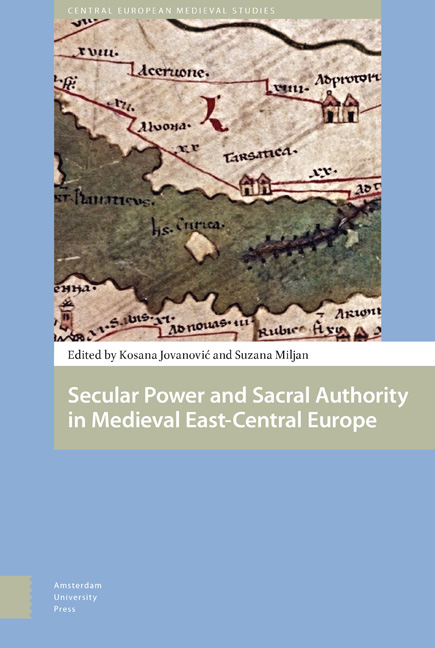Book contents
- Frontmatter
- Contents
- List of Figures and Tables
- Acknowledgements
- Foreword
- Folklore of the Medieval Kings of Hungary: Preliminary Research Report
- Variations on Nobility in Central and South-Eastern Europe: An Introduction
- The Changes of Office of Ban of Slavonia after the Mongol Invasion in Hungary (1242-1267)
- The Reconstruction and Role of Roads in the Formation of a Medieval Cultural Landscape: The Example of Episcopal Estates of Dubrava, Ivanić and Čazma
- From Castle-Warrior to Nobleman: Case Study of a Family of Slavonian Lesser Nobility
- Late Medieval Village in Turopolje (Slavonia): The Example of Donja Lomnica
- Economic Development and Transformation of the Pauline Monasteries near Senj under the Frankapan Patronage
- The Society of the Noble Judges in Northeastern Hungary during the Reign of King Sigismund (1387-1437)
- Development of Ragusan Diplomatic Service in the First Half of the Fifteenth Century: Father and Son at the Court of Duke Sandalj Hranić
- Croatian Students at the University of Prague in the Fifteenth Century
- A Contribution to Medieval Croatian Diplomatics: Cyrillic Charters of Croatian Nobility from the Franciscan Monastery on Trsat in Rijeka
- Peter of Crkvica, a Man Who Could Be Trusted: The Career of a Middle-Ranking Cleric and Diplomat in the Kingdom of Hungary in Mid-Fifteenth Century
- The Nobility of the Despotate of Serbia between Ottoman Empire and Hungary (1457-1459)
- List of Contributors
- Index
Economic Development and Transformation of the Pauline Monasteries near Senj under the Frankapan Patronage
Published online by Cambridge University Press: 12 December 2020
- Frontmatter
- Contents
- List of Figures and Tables
- Acknowledgements
- Foreword
- Folklore of the Medieval Kings of Hungary: Preliminary Research Report
- Variations on Nobility in Central and South-Eastern Europe: An Introduction
- The Changes of Office of Ban of Slavonia after the Mongol Invasion in Hungary (1242-1267)
- The Reconstruction and Role of Roads in the Formation of a Medieval Cultural Landscape: The Example of Episcopal Estates of Dubrava, Ivanić and Čazma
- From Castle-Warrior to Nobleman: Case Study of a Family of Slavonian Lesser Nobility
- Late Medieval Village in Turopolje (Slavonia): The Example of Donja Lomnica
- Economic Development and Transformation of the Pauline Monasteries near Senj under the Frankapan Patronage
- The Society of the Noble Judges in Northeastern Hungary during the Reign of King Sigismund (1387-1437)
- Development of Ragusan Diplomatic Service in the First Half of the Fifteenth Century: Father and Son at the Court of Duke Sandalj Hranić
- Croatian Students at the University of Prague in the Fifteenth Century
- A Contribution to Medieval Croatian Diplomatics: Cyrillic Charters of Croatian Nobility from the Franciscan Monastery on Trsat in Rijeka
- Peter of Crkvica, a Man Who Could Be Trusted: The Career of a Middle-Ranking Cleric and Diplomat in the Kingdom of Hungary in Mid-Fifteenth Century
- The Nobility of the Despotate of Serbia between Ottoman Empire and Hungary (1457-1459)
- List of Contributors
- Index
Summary
The Order of Saint Paul the First Hermit was one of the most important monastic orders in the Kingdom of Hungary-Croatia. On the level of the Kingdom, only the Franciscans had more friaries. The Pauline role in shaping relations between several entities within the Kingdom, together with their monastic and economic transformation, influenced their local communities. Thus, researching the Paulines provides information not just about their monastic history but it also offers some insights about their local communities, benefactors, and the connections developed among them.
In this article, I will deal with two Pauline littoral monasteries near Senj – Holy Savior (Sv. Spas) in Ljubotina and St. Helen (Sv. Jelena) in Vlaška draga, both part of the Pauline vicariate of Gvozd, which included all the monasteries south of the hill Petrova Gora. Head of the vicariate was St. Nicholas (Sv. Nikola) in Gvozd near Modruš. The exact time of the establishment of the vicariate is unknown, but one can follow its existence along with the St. Nicholas monastery. This vicariate had some particularities; such predicaments as the usage of language and the Glagolitic script. In addition, most of the monasteries were either founded or to some extent supported by the Frankapan family. By taking the Frankapan patronage into consideration and putting it into the context of the Pauline economic and monastic transformation and development, both on the local and Kingdom-wide scales, one should be able to attest several different patterns and local peculiarities.
When trying to establish clear connections (especially the nature of those connections) between two complex entities such as an aristocratic family and a monastic order, one has to take into consideration all available sources. As there are still no systematic archeological surveys of the Pauline monasteries, the backbone of this article is the written sources, especially grants and donations given by the various members of the local communities, such as the aristocracy, the lesser nobility, or rich burghers to the Pauline monasteries. In addition, most of the sources are legal documents such as foundation charters, donations, tax and toll exemptions, testaments, judicial decisions, and so forth. The time scope of this research covers the period from the foundation of the given houses to their abandonment or desolation in the first decades of the sixteenth century.
- Type
- Chapter
- Information
- Publisher: Amsterdam University PressPrint publication year: 2018

